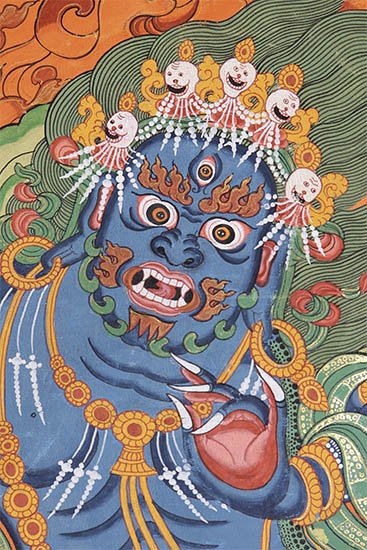Bhumja, Bhūṃjā, Bhuñja, Bhunja: 3 definitions
Introduction:
Bhumja means something in Buddhism, Pali, Jainism, Prakrit, Hindi. If you want to know the exact meaning, history, etymology or English translation of this term then check out the descriptions on this page. Add your comment or reference to a book if you want to contribute to this summary article.
In Buddhism
Tibetan Buddhism (Vajrayana or tantric Buddhism)
Source: OSU Press: Cakrasamvara SamadhiBhuñja (भुञ्ज) refers to “eating” or “enjoying” [?], according to the Guru Mandala Worship (maṇḍalārcana) ritual often performed in combination with the Cakrasaṃvara Samādhi, which refers to the primary pūjā and sādhanā practice of Newah Mahāyāna-Vajrayāna Buddhists in Nepal.—Accordingly, “Oṃ an offering of eatables all combined, full of food to be enjoyed, Provided with drink to be enjoyed, an acceptable offering from her, Five kinds of virtuous conduct, completely full of egg-born fish, Of one mind with the Nirvikalpa, eat and enjoy Hūṃ (bhuñja bhuñja hūṃ)”.

Tibetan Buddhism includes schools such as Nyingma, Kadampa, Kagyu and Gelug. Their primary canon of literature is divided in two broad categories: The Kangyur, which consists of Buddha’s words, and the Tengyur, which includes commentaries from various sources. Esotericism and tantra techniques (vajrayāna) are collected indepently.
Languages of India and abroad
Hindi dictionary
Source: DDSA: A practical Hindi-English dictionaryBhūṃjā (भूंजा):—(nm) parched grain.
...
Prakrit-English dictionary
Source: DDSA: Paia-sadda-mahannavo; a comprehensive Prakrit Hindi dictionaryBhuṃja (भुंज) in the Prakrit language is related to the Sanskrit word: Bhuj.
Prakrit is an ancient language closely associated with both Pali and Sanskrit. Jain literature is often composed in this language or sub-dialects, such as the Agamas and their commentaries which are written in Ardhamagadhi and Maharashtri Prakrit. The earliest extant texts can be dated to as early as the 4th century BCE although core portions might be older.
See also (Relevant definitions)
Starts with: Bhumjaga, Bhumjana, Bhumjava, Bhumjavaya, Bhumjavia, Bhumjaya, Bhunjaka, Bhunjana.
Ends with: Anubhumja, Bhadabhumja, Pabhumja, Paribhumja, Sambhumja, Uvabhumja.
Relevant text
Search found 3 books and stories containing Bhumja, Bhūṃjā, Bhuṃja, Bhuñja, Bhunja; (plurals include: Bhumjas, Bhūṃjās, Bhuṃjas, Bhuñjas, Bhunjas). You can also click to the full overview containing English textual excerpts. Below are direct links for the most relevant articles:
Puranic encyclopaedia (by Vettam Mani)
Apadana commentary (Atthakatha) (by U Lu Pe Win)
Commentary on the Biography of the thera Sumaṅgala < [Chapter 2 - Sīhāsaniyavagga (lion-throne section)]
Vinaya Pitaka (1): Bhikkhu-vibhanga (the analysis of Monks’ rules) (by I. B. Horner)
Monks’ Expulsion (Pārājika) 4: Case rulings < [Monks’ Expulsion (Pārājika) 4]